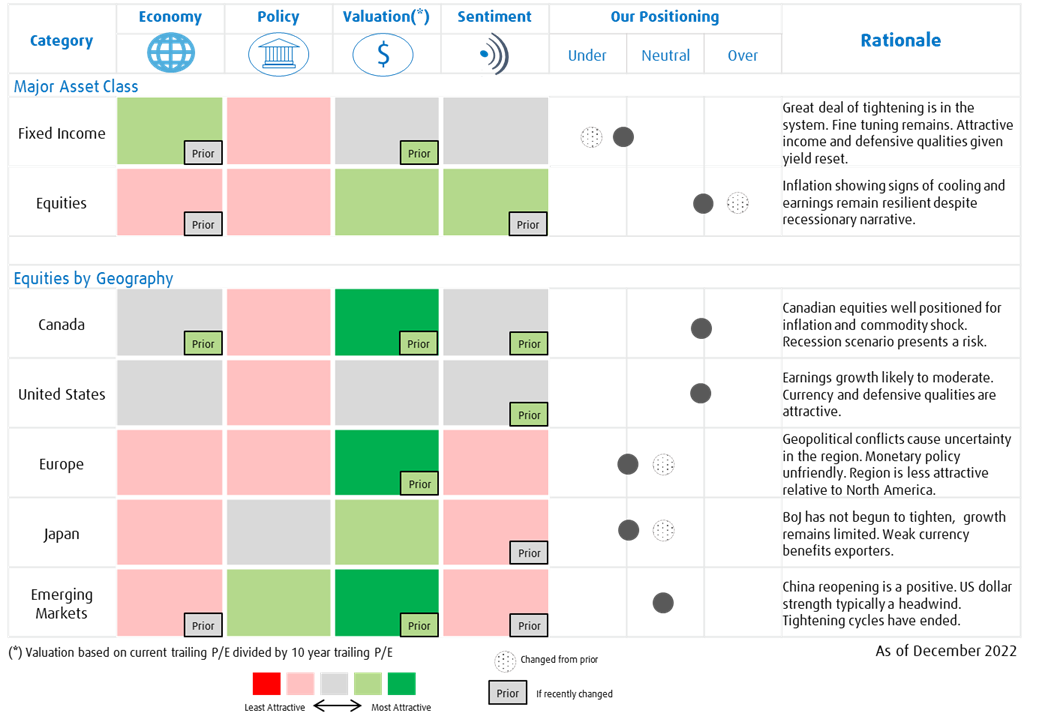Executive Summary
We have endured almost a full year of difficult and volatile equity and bond markets. Capital markets have been adjusting to the reality of high inflation, higher interest rates, less easy money, slowing growth, and increased geopolitical tensions.
The global economy is slowing. The post-pandemic pace of economic activity is returning to normal after 2021’s juiced reopening pace. During COVID, central bankers and governments saturated the economy with money, but that contributed to high inflation. Now central banks are unwinding easy money policies and raising interest rates to tame runaway inflation.
In our opinion, many equity and bond markets have come a long way toward adjusting to the current reality. Looking ahead, we see better investment opportunities today than we did a year ago.
Equities
Equity markets need to adjust on three fronts: complacency toward risk; a rising risk-free rate; and the future path for earnings growth.
A lot of complacency has been scrubbed from the system. Savvy investors know that investing when there is more fear than greed often leads to good outcomes. Today, there is more fear than greed versus a year ago.
The reset to higher bond yields and a higher risk-free rate is closer to the end than the beginning. Gale-force headwinds for stocks are softening into a mild breeze that is a potential tailwind in 2023.
Expectations for earnings growth in 2023 are modest. Most valuations have reset below their 20-year average. If the economy experiences a soft landing (no recession and inflation cools) or a shallow recession (and inflation cools) both scenarios underpin our base-case outlook. We feel equities can deliver total returns in 2023 in the neighbourhood of 8% to 12%. Our targets are 22,000 for the S&P/TSX Composite and 4,400 for the S&P 500.
Fixed Income
We feel a great deal of recalibration in fixed income markets has been done. Bond markets are pricing in a peak U.S. Federal Reserve Funds rate between 4.75% and 5.0% and a peak Bank of Canada rate between 4.25% and 4.5%. We see these numbers as fully pricing in all the expected moves. If central banks unexpectedly stop short of these levels, it would be a boon for fixed income.
Many of the untenable imbalances due to the extraordinary measures undertaken during the pandemic have been worked off. The fixed income market is currently better positioned to deliver on the dual mandate of providing a return contribution and mitigating risk. The yield inside our fixed income portfolios is more attractive now than it has been in more than a decade (around 5% in our core fixed income solution). The ability of fixed income to provide downside protection has improved.
In our base-case scenario, our end-of-2023 call is for the yield curve to steepen as 2-year and 10-year Canadian bonds lineup to yield 3.25%. There will be volatility across the year as bond yields wobble around on recession and inflation fears, but the income now coursing through portfolios should generate a mid-single-digit return in 2023.
Our Positioning
We remain reasonably close to our long-term strategic benchmarks with some prudent tactical tweaks. For 2023, our bias leans toward increasing our equity exposure.
Our fixed income positions remain at a slight underweight. Coupon income and maturing securities in our bond portfolios are being reinvested at higher yields. We believe our bond positions will provide a level of safety if a recession takes hold.
We remain slightly overweight equities. We are underweight international developed markets (primarily Europe and Japan) and overweight to North American equities, remaining neutral on Emerging Markets equities.
The coming year will begin with downside risk and (hopefully) cooling inflation – but no recession (or perhaps just a mild one). We see better investment opportunities in the year ahead. After this difficult year of volatile equity and bond markets, everyone will welcome a return to normal.
Our Strategy Summary & Asset Class Outlook

Read the full PDF report here: 2023 Market Outlook – The End of Free Everything? Could Simply Be a Return to Normal
Information contained in this publication is based on sources such as issuer reports, statistical services and industry communications, which we believe are reliable but are not represented as accurate or complete. Opinions expressed in this publication are current opinions only and are subject to change. BMO Private Wealth accepts no liability whatsoever for any loss arising from any use of this commentary or its contents. The information, opinions, estimates, projections and other materials contained herein are not to be construed as an offer to sell, a solicitation for or an offer to buy, any products or services referenced herein (including, without limitation, any commodities, securities or other financial instruments), nor shall such information, opinions, estimates, projections and other materials be considered as investment advice, tax advice, a recommendation to enter into any transaction or an assurance or guarantee as to the expected results of any transaction.
You should not act or rely on the information contained in this publication without seeking the advice of an appropriate professional advisor.
BMO Private Wealth is a brand name for a business group consisting of Bank of Montreal and certain of its affiliates in providing private wealth management products and services. Not all products and services are offered by all legal entities within BMO Private Wealth. Banking services are offered through Bank of Montreal. Investment management, wealth planning, tax planning and philanthropy planning services are offered through BMO Nesbitt Burns Inc. and BMO Private Investment Counsel Inc. Estate, trust, and custodial services are offered through BMO Trust Company. BMO Private Wealth legal entities do not offer tax advice. BMO Trust Company and BMO Bank of Montreal are Members of CDIC.
®Registered trademark of Bank of Montreal, used under license.